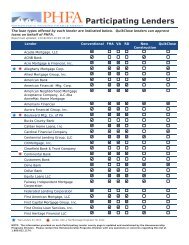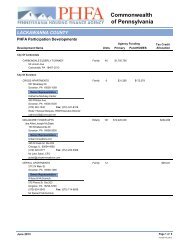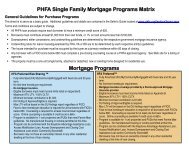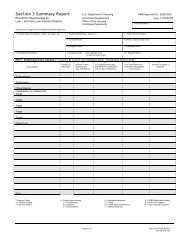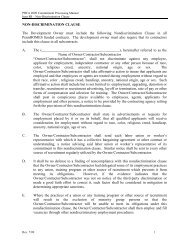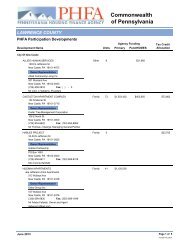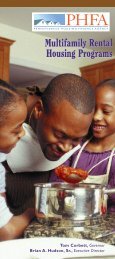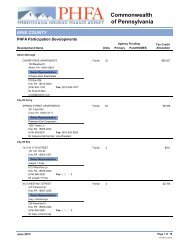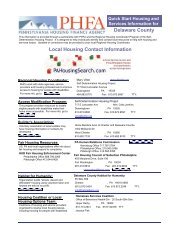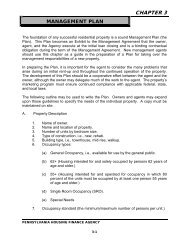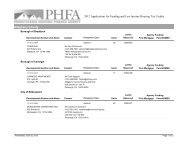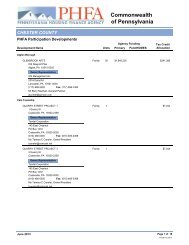2012 PHFA Annual Report - Pennsylvania Housing Finance Agency
2012 PHFA Annual Report - Pennsylvania Housing Finance Agency
2012 PHFA Annual Report - Pennsylvania Housing Finance Agency
You also want an ePaper? Increase the reach of your titles
YUMPU automatically turns print PDFs into web optimized ePapers that Google loves.
<strong>Pennsylvania</strong> <strong>Housing</strong> <strong>Finance</strong> <strong>Agency</strong><br />
Notes to Financial Statements<br />
(in thousands of dollars) June 30, <strong>2012</strong> and 2011<br />
13. Pension Plans<br />
PLAn Description<br />
Substantially all eligible full-time employees are participants<br />
in the <strong>Pennsylvania</strong> <strong>Housing</strong> <strong>Finance</strong> <strong>Agency</strong> Employees’<br />
Retirement Plan (“Plan”) or Government Excess Benefit<br />
Plan (“Excess Plan”), which are both defined benefit singleemployer<br />
plans. Pension plan assets are included in the basic<br />
financial statements of the <strong>Agency</strong>. The Plan and Excess Plan<br />
do not issue stand-alone statements.<br />
Full-time employees become eligible for participation in the<br />
Plan after completion of one year of service. A participant’s<br />
benefits vest upon the completion of five years of service.<br />
Under the provisions of the Plan, participants with prior<br />
military service may receive credit for their time of service<br />
providing they contribute funds equivalent to the cost of their<br />
pension benefits accumulated during their military service.<br />
A participant is eligible for normal retirement after attainment<br />
of age 65, or age 55 and completion of 30 years of service,<br />
or at any age after completion of 35 years of service.<br />
The Plan also provides early and late retirement provisions<br />
and death and disability benefits. The normal retirement<br />
pension is payable monthly during the participant’s lifetime<br />
with payments ceasing upon the participant’s death.<br />
All participants in the Plan who will receive retirement benefits<br />
in an amount that is less than the benefits otherwise payable<br />
under the terms of the Plan due to limitations on benefits<br />
imposed by Internal Revenue Code (“IRC”) Section 415 shall<br />
automatically participate in the Excess Plan. Participation in<br />
the Excess Plan will cease for any year in which the retirement<br />
benefits from the Plan do not exceed the limitation imposed by<br />
IRC Section 415. Pension payments under the Excess Plan are<br />
paid in the same form as the pension benefits payable under<br />
the Plan.<br />
Funding Policy<br />
Employees hired on or after January 1, 2009 contribute 3%<br />
of compensation to the Plan. Employees hired on or before<br />
December 31, 2008 do not contribute to the Plan or Excess<br />
Plan. Contribution requirements and benefit provisions of the<br />
Plan and Excess Plan are established and may be amended by<br />
the Members of the Board.<br />
AnnuAL Pension Cost<br />
and Net Pension Asset<br />
The Plan and Excess Plan’s funding policy provides for<br />
actuarially determined periodic contributions at rates that,<br />
for individual employees, increase gradually over time so that<br />
sufficient assets will be available to pay benefits when due.<br />
The <strong>Agency</strong>’s annual pension costs and net pension assets<br />
of the Plan and Excess Plan for the years ended June 30 were<br />
as follows:<br />
<strong>2012</strong> 2011<br />
<strong>Annual</strong> required contribution (ARC) $ 2,961 $ 2,829<br />
Interest on net pension asset (183) (100)<br />
Adjustment to ARC 276 151<br />
<strong>Annual</strong> pension cost 3,054 2,880<br />
Contributions made (4,365) (3,982)<br />
Increase in net pension asset (1,311) (1,102)<br />
Net pension asset<br />
beginning of year (2,670) (1,568)<br />
Net pension asset end of year $ (3,981) $ (2,670)<br />
The net pension asset is included as other noncurrent assets<br />
on the Balance Sheets of the General Fund.<br />
ThrEE-yEAr Trend InforMAtion<br />
for tHE PLAn and ExCEss PLAn<br />
<strong>Annual</strong> Pension Percentage of net Pension<br />
Calendar Year Ended Cost (“APC”) APC Contributed (Asset)<br />
December 31, 2011 $ 3,054 143% $ (3,981)<br />
December 31, 2010 2,880 138 (2,670)<br />
December 31, 2009 3,084 104 (1,568)<br />
FunDED Status and Funding Progress<br />
As of January 1, <strong>2012</strong>, the most recent actuarial valuation date,<br />
the Plan and Excess Plan was 73.2% funded. The actuarial<br />
accrued liability for benefits was $67,072, and the actuarial<br />
value of assets was $49,073, resulting in an unfunded actuarial<br />
accrued liabilities (“UAAL”) of $17,999. The covered payroll<br />
(annual payroll of active employees covered by the Plan and<br />
Excess Plan) was $15,697 and the ratio of the UAAL to the<br />
covered payroll was 114.7%.<br />
The Schedule of Funding Progress, presented as required<br />
supplementary information following the notes to the financial<br />
statements, presents multiyear trend information about<br />
whether the actuarial values of Plan and Excess Plan assets<br />
are increasing or decreasing over time relative to the actuarial<br />
accrued liability for benefits.<br />
Actuarial Methods and AssuMPtions<br />
In the actuarial valuation as of January 1, <strong>2012</strong>, the aggregate<br />
actuarial cost method is used. The actuarial assumptions<br />
include a 7.5% investment rate of return, projected salary<br />
increases of 4.5% per year and no post-retirement benefit<br />
increases. Both the rate of return of investments and projected<br />
salary increases include a moderate rate of inflation component<br />
based on historical averages. The actuarial value of assets<br />
is determined using techniques that spread the effects of<br />
s hort-term volatility in the market value of investments smooth<br />
over a five-year period. Because the aggregate actuarial cost<br />
method does not identify or separately amortize the UAAL,<br />
information about the Plan and Excess Plan’s funded status<br />
and funding progress has been prepared using the entry age<br />
actuarial cost method for that purpose.<br />
14. Postemployment Benefits<br />
Other than Pensions<br />
PLAn Description<br />
The <strong>Agency</strong> sponsors a single-employer defined benefit plan,<br />
which includes the <strong>Pennsylvania</strong> <strong>Housing</strong> <strong>Finance</strong> <strong>Agency</strong><br />
Postemployment Benefits Plan (“Plan”) to provide certain other<br />
postemployment benefits (“OPEB”) to all former employees<br />
who are members of the Employees’ Retirement Plan currently<br />
receiving retirement income. Such benefits are available to<br />
members’ spouses during the life of the retiree. Specific details<br />
of the Plan include the provision of limited hospitalization,<br />
major medical insurance, physician services and prescription<br />
drug coverage. The <strong>Agency</strong> is under no statutory or contractual<br />
obligation to provide these postretirement healthcare benefits.<br />
Plan assets and liabilities are included in the basic financial<br />
statements of the <strong>Agency</strong>. Because the Plan consists solely<br />
of the <strong>Agency</strong>’s commitment to provide OPEB through the<br />
payment of premiums to insurance companies on behalf of<br />
its eligible retirees, no stand-alone financial report is either<br />
available or generated for the Plan.<br />
68<br />
<strong>2012</strong> Financial statements annual report <strong>2012</strong><br />
69



